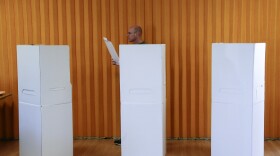Kids from less affluent homes, even when they have health insurance, aren't as likely as others to get vision screenings that can identify conditions like lazy eye before the damage becomes irreversible.
Researchers at the University of Michigan examined commercial health insurance claims data between 2001 and 2014 for nearly 900,000 children from birth to age 14. They tracked how often kids at different family income levels visited ophthalmologists and optometrists and the diagnosis rates for strabismus (crossed eyes) and amblyopia (lazy eye).
The two conditions are relatively common, serious eye disorders in children. Because the eyes are seeing different things, the brain suppresses the vision in one eye. If not corrected by age 10, either condition can result in permanent vision loss. Treatment generally involves glasses, surgery, eyedrops or patches, or some combination.
Children in families with the lowest net worth (less than $25,000 a year) had 16 percent fewer eye care visits than those in the middle-income category ($150,000 to $250,000 a year), the study found. Meanwhile, kids from families with the highest net worth ($500,000 or more annually) had 19 percent more visits to eye care professionals than those in the middle-income group.
Lower-income kids were also less likely to be diagnosed with strabismus or amblyopia than were children from higher-income families. By age 10, an estimated 3.6 percent of children in the lowest-income category were diagnosed with strabismus, and 2 percent were diagnosed with amblyopia, the study found. For kids in the highest-income bracket, the estimated diagnoses were 5.9 percent for strabismus and 3.1 percent for amblyopia.
"We think that affluence is driving the eye care visit and the visit is driving the diagnosis of eye disease," said Dr. Joshua D. Stein, the study's lead author and an associate professor of ophthalmology and visual sciences at the University of Michigan's medical school. The findings were published in the August issue of the journal Health Affairs.
The researchers estimate that the lack of eye care visits by lower-income children resulted in 12,800 missed cases of strabismus and 5,400 missed cases of amblyopia.
Many children receive vision screening in schools, which wouldn't appear in the claims data that were analyzed. Children who fail a school vision screening, however, should be referred to an optometrist or ophthalmologist for further testing, and that visit would show up in the claims data.
Less affluent parents may have more difficulty taking time off from work or face transportation challenges getting a child to an eye care provider, said Stein, and there may be fewer eye care providers available in less affluent areas.
Under the health law, services recommended by the U.S. Preventive Services Task Force, an independent panel of medical experts, are covered by insurance without requiring most people to pay anything out of pocket. The task force recommends that children between the ages of 3 and 5 receive at least one vision screening to check for amblyopia. That recommendation is being updated.
Please contact Kaiser Health News to send comments or ideas for future topics concerning health insurance.
Copyright 2016 Kaiser Health News. To see more, visit Kaiser Health News.






